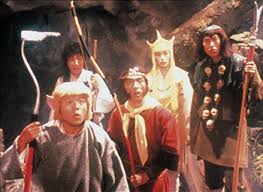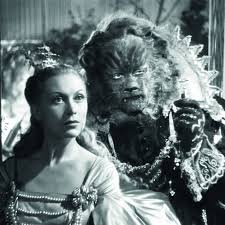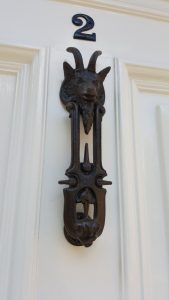In response to The Guardian’s Top Ten Shapeshifters in Fiction (which is very noughties) and Kaja’s lively alternative list, I am posting my own top ten which is a little bit more retro! A shapeshifter is usually understood to be a person or being that can morph into another form, or undergo a bodily transformation. In Ovid, the theme of Metamorphoses is change, and the narratives are meant to reflect the never ending flux and reflux of the universe. I am collapsing the boundaries, however liminal, between transformation, shapeshifting and metamorphosis in the list below (which may be controversial). The shapeshifter’s position in the top ten reflects the power of their influence on my own formative imagination.
- Monkey (From the Japanese TV series ‘Monkey’, or ‘Monkey Magic’, circa 1970).

Monkey, was made by NTV in the late 1970s. It is a quest narrative drawn from a sixteenth-century Chinese epic called Hsi Yu Chi (or ‘Journey to the West’). The title of ‘Monkey’ comes from Arthur Waley’s English translation of the folk tales (1942). The tales, set in 630 AD, describe the demons and monsters who try to stop the Tang Priest (Tripitaka) from reaching a Buddhist monastery in India to retrieve sacred scriptures. Monkey, comic and brave, escorts Tripitaka, the pig monster Pigsy, and the water sprite Sandy, on their perilous mission. According to the theme song Monkey was ‘born from an egg on a mountain top’ and becomes ‘the funkiest monkey that ever popped!!”
Does he qualify as a shapeshifter? Well, Monkey can change form (into a hornet in Episode 3) and when the journey begins he transforms into a girl to trick Pigsy. Monkey’s other magic powers include summoning a cloud which he flies on; the use of a magic wishing staff, which he can shrink and grow at will (and store in his ear); and the ability to conjure monkey warriors by blowing on hairs plucked from his chest. I have never forgotten this funky monkey. He is my number one shapeshifter. You can find the book that the series is based on here and the boxed set (which is very expensive.. sigh). And this is a rather funky tribute site that will make you curious I think.
- Satan (Milton, Paradise Lost, 1667).

Satan is an archangel who rebels against God and is cast out of the Kingdom of Heaven. We first see him chained to a burning lake in perpetual darkness. These are punishments the Almighty has designed for him in return for his disobedience. In the poem Satan is shown to be more of an imaginative and creative being than God (even though God has created the universe) and he is something of a trickster, as well as a shapeshifter and freedom fighter (‘better to reign in hell than serve in heaven’). Milton inspires sympathy for the devil who wages war against ‘the tyranny of heaven’ (a battle which he cannot possibly win, since God is omniscient and omnipotent). The description of Satan’s perilous final journey to the new world, to seek out ‘some new race called man’ is one of the most beautiful passages in English poetry. These lines also inspired Phillip Pullman’s Dark Materials Trilogy:
Into this wild abyss,
The womb of nature and perhaps her grave,
Of neither sea, nor shore, nor air, nor fire,
But all of these in her pregnant causes mixed
Confus’dly, and which thus must ever fight,
Unless the almighty maker them ordain
His dark materials to create more worlds,
Into this wild abyss the wary fiend
Stood, on the brink of hell and looked awhile,
Pondering his voyage (II.910-919)
I now teach this work to undergraduates but I came to it via Mary Shelley’s Frankenstein as it is one of the books read by the monster in the 1819 novel. The monster, though innocent, identifies with Satan, not Adam, because Satan too is rejected by his creator (whereas Adam is loved unconditionally by God and has a companion in Eve). Does Satan qualify as a shapeshifter? Well, Milton is drawing on Ovid’s Metamorphoses as well as the book of Genesis in this epic and Satan’s final incarnation is of course in the form of a talking snake. Eaten up with malice, and ‘bent on man’s destruction’, he appears in the garden as a creeping black mist and enters the sleeping serpent through its mouth. On waking and finding Eve, he changes the course of human history forever. This is Epic in the true sense of the word!
I recommend Stephen Orgel and Jonathan Goldberg’s edited edition in Oxford Worlds Classics. And you can read Phillip Pullman’s controversial introduction to the poem in a Blackwell edition here.
- Count Dracula (Bram Stoker, 1897).
Dracula is not the first shapeshifting vampire (Le Fanu’s Carmilla (1871) turns into a cat) but his are the most uncanny transformations. He arrives in Whitby in the form of a wolf (or large dog) and is famously seen by Jonathan Harker scaling the castle walls in the shape of a lizard or bat. This scene appears on the cover of the 1903 edition of the novel and it is thought to be the only illustration of Dracula that Stoker ever saw.

Dracula has the power of necromancy, he can control the dead, direct the elements and ‘command all the meaner things, the rat, and the owl and the bat-the moth, and the fox, and the wolf; he can grow and become small; and he can at times vanish and become unknown’. There are many representations of these attributes in film but my favourite has to be Tod Browning’s 1931 masterpiece (written about so well by Stacy Abbott in the Open Graves, Open Minds book). The scene below shows a wonderfully mannered and paranoid Renfield being driven in a stagecoach by Dracula in the form of a bat (if you look carefully) and it is followed by the iconic entrance of Bela Lugosi as the Count, together with some rather curious armadillos (which nobody can explain). ‘Listen to them, the creatures of the night. What music they make!’.
- The tragic bear from The Singing Ringing Tree, circa 1960).
The Singing Ringing Tree is a cult TVs series which the BBC bought from East Germany in the 1960s. It seems to have terrified a whole generation of children. There is a complete programme on BBC Radio 4 dedicated to it. Those who have seen it will remember the evil dwarf, the selfish princess and giant spooky fish, trapped in a frozen lake, but my favourite character is the rather shy and wistful bear. He is really a prince who has been changed into a bear by the evil dwarf for trying to steal the magical singing ringing tree. He hides in the forest, because of his ugliness (much like Frankenstein’s monster) and is often seen clutching a red rose (or a branch of the magical tree), a reference to Beauty and the Beast, which leads me on nicely to number 5.

- Beast (Cocteau, La Belle et la Bête, 1946).

Like Kaja, I love the noble characterisation of Beast in Robin Mckinly’s Beauty (1978) but my favourite representation of him comes from Jean Cocteau’s 1946 film. It was this film that made the story so attractively gothic and inspired a whole genre of paranormal romances that draw unashamedly, and in a very postmodern way on this reincarnation of the original fairy tale. The set designs and cinematography are intended to evoke the illustrations and paintings of Gustave Doré and Vermeer. The reissued BFI DVD has an insightful and informative commentary by friend of OGOM Sir Christopher Frayling.

‘Beauty and the Beast’ belongs to the ‘Animal Bridegroom’ cycle of fairy tales (written about by Bruno Bettelheim and others). The original fairy tale by Jeanne-Marie Le Prince de Beaumont (c.1740) is nicely translated and introduced in The Norton edition of The Classic Fairy Tales, ed. by Maria Tatar. It is one of only a few well known fairy tales attributed to a woman and is widely believed to be a metaphor for arranged marriage (with the protagonist Beauty being sacrificed to a beastly husband by her father in exchange for wealth and prosperity). I am fascinated by how the animal representation of the beast changes from a warthog to a lion or a bear in different retellings, and by our changing relationship to it. Marina Warner argues that ‘the attraction of the wild, and the wild brother in twentieth-century culture, cannot be over estimated; as the century advanced, in the cascade of deliberate revisions of the tale, Beauty stands in need of the Beast, rather than vice versa and the beast’s beastliness is good, even adorable’ (Warner, ‘Go Be a Beast’, Beast, 307). Victorian readers sympathised with Beauty and the power of female virtue triumphing over crude animal desire, whereas twenty-first century audiences are more likely to embrace Beast, in all his wildness and alterity. This idea of the sympathetic animal ‘other’ takes me to no. 6.
- The Tiger’s Bride (Angela Carter, The Bloody Chamber, 1993)
Carter indulges in a subversive and unexpected reversal of the traditional ending of the beauty and the beast plot. Instead of Beauty transforming the beast into a human, Beauty herself transforms into a beast. She literally becomes furred in this feline version in her manifestation as the tiger’s bride. Genius. If you haven’t read Carter yet, you really must. Here’s a handy link to this collection.
- Mrs. Mothersole (M.R. James, ‘The Ash Tree’, 1904).
Mrs Mothersole is the shapeshifting Witch in M.R. James’s ‘The Ash Tree’ (Ghost Stories of Antiquary, 1904). The story takes place in Castringham Hall in Suffolk, the setting of the 1690 witch trials. It is here that Mrs Mothersole was hanged as a witch on the evidence of Sir Matthew Fell. The squire claimed he saw the woman gathering sprigs from his ash tree then running from the scene in the shape of a hare. At the execution she muttered the ominous lines ‘there will be guests at the hall’ and the tree is later found to be infested with these ‘guests’ in the form of devilish spiders with greyish hair and human faces, the spawn of the dead witch. The tale is peculiarly haunting and memorable and many generations of the Fell family fall prey to the witch curse. The name Mothersole appears on gravestones in the churchyard at Livermere, the Suffolk village where MRJ spent much of his childhood. You can listen to the full story being read by Michael Hordern below:
And here is a clip showing the ending of the 1975 TV adaptation
8. Hobgoblin Puck (Shakespeare, A MidSummer Night’s Dream (circa. 1594-6), Julia Kagawa, The Iron King, 2011 )
I have always been intrigued by the figure of Puck in folklore and more recently I have been doing some intertextual readings of Julia Kagawa’s The Iron King . In the novel the teenage protagonist Meghan is unaware that she is Oberon’s daughter and that her best friend Robbie is actually Robin Goodfellow, or Puck, a very old faery, who has ballads, poems and stories written about him. In fact, Puck is a half domestic fairy of the hobgoblin type, the best known of all hobgoblins. Mentions of him in Elizabethan literature are common (hence Shakespeare uses him as a character in A Midsummer Night’s Dream). Interestingly, Kagawa’s Puck is something of a shapeshifter and Pooka, the Irish Puck, often takes animal form, especially that of a horse. According to sources in the Norton Shakespeare, Puck inherited his tricksy nature from the fairies but had to be given fairy powers by his superhuman father (for background see Robin Goodfellow: his mad pranks and merry jests, 1628). Shakespeare’s Puck is mischievous and meddling; he takes delight in the discord he has helped to sow among the mortal couples but he is not the originator of the discord; in fact, he is the indispensable agent for setting things right (Norton Shakespeare, p. 808). In this role he is both the mischief maker and match maker . Hence he is the perfect vehicle for keeping Meghan away from Queen Mab’s son Ash, the Prince of the Winter Court, and causing havoc with the would-be lovers in the Never Never world of Julia Kagawa’s enchanting paranormal romance.

- The Little Mermaid (Hans Andersen, 1837).
‘The Little Mermaid’ was amongst the first of Hans Andersen’s tales to be translated into English in 1846. It is a story of deep desire, profound pain and unbearable loss, an allegory for the search for human redemption. When the Little Mermaid falls in love with a Prince she does not want to return to the sea. She is granted feet and legs but is told that every step will be like treading on a sharp knife ‘enough to make your feet bleed’. As her love for the Prince and life outside the sea grows she is forced to give up her voice to the sea witch and can no longer sing or speak. When it becomes clear that she has not secured the love of the prince she is given a knife to stab into his heart and told that when the warm blood splashes over her feet they will grow together into a fishes tail and she will be able to return to the sea. You will have to read the story to find out what happens next! There is an excellent translation in Classic Fairy Tales ed. by Maria Tatar (linked to above).
The Little Mermaid’ was celebrated by the Victorians but has been criticized in recent years for promoting silence as an ideal of female behaviour. This is a misreading, I think, as the mermaid’s voiceless plight is a symbol of her continued oppression. There is authenticity here too as this trope is rooted in the ancient myths of mermaids, selkies and seabrides who often marry mortals on certain conditions, and whose silence is traditionally part of the bargain. It is a tale of a love that dare not and cannot speak its name. Oscar Wilde’s ‘The Fisherman and his Soul’ (1891) and H. G. Well’s ‘The Sea Lady (1903) are both indebted to it. I am so taken with this tale that I have written my own diabetic homage to it, entitled ‘The Little Sugar Maiden’, for OGOM’s Books of Blood project (in which I investigate blood imagery in fairy tales).
10. Black Phillip (Egger, 2016)
Black Phillip is the seventeenth-century goat star of Robert Egger’s debut film The Witch; he is the devil incarnate.

My perception of goats is largely influenced by my obsession with the Norwegian folk tale ‘The Three Billy Goats Gruff’ (with ugly troll), and wanting to be Heidi as a child (oh, and the Lonely Goatherd puppet show from The Sound of Music), but my daydream of living on a mountain top with a kindly grandfather and a herd of skipping goats has been forever shattered by the appearance of Black Phillip. Thanks to ‘The Witch’, I will be walking with apprehension past any fields or barns which may contain talking goats. Remarkably, Black Phillip has his own twitter feed (@BlackPhillip) and there is even a biography. I tried to watch him with the demonic children in the barn again but it is just too plain scary! You can see him misbehaving in the clip below:
https://www.youtube.com/watch?v=AT3FY8T9b3U
Despite his wonderful voice, he has to be one of the most chilling and unsettling animals in film ever.
Overall I have two trees (reflecting my botanical interests), five animals who shift shape (inspired by research for OGOM’s Company of Wolves) and three devils, illustrating my gothic sensibilities (Dracula is the anti-Christ, Satan is, well, Lucifer, and Black Phillip is the devil incarnate). To make matters worse my neighbours at no. 2 have this demonic doorknob which looks remarkably like Black Phillip!! I have planted St John’s Wort and will be ready with the holy water should they want to call on me unexpectedly.

Please do comment on my list, or Kaja’s or the original Guardian article, or suggest your own top ten and we will respond!! If you have a useful definition of the ‘shapeshifter’ we would be interested too. In the meantime I eagerly await Bill’s list coming soon.
